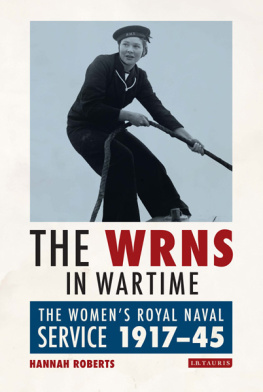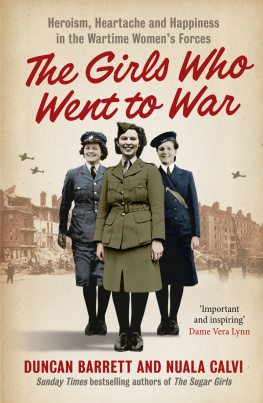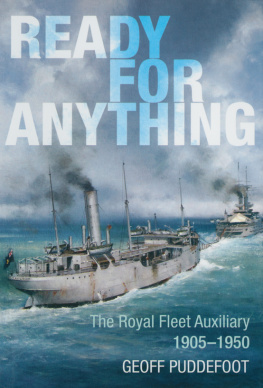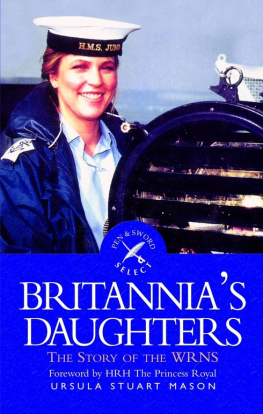
Hannah Roberts holds a PhD in War Studies from Kings College London. She is Head of Sociology at Godalming College.
This book offers a historic and chronological overview of the WRNS with particular attention to the role of the individual. It is a solid piece of historical research which makes a genuine contribution to knowledge in the field, and has some lovely colour from the oral interviews conducted.
Corinna Peniston-Bird, Senior Lecturer in Gender History, Lancaster University
A new way of seeing naval history has arrived. This book does for the navy what Lucy Noakes has done for the army. It's analytical, combative, and aware of how gendered norms shape military organisations and the women within them in wartime and beyond.
Jo Stanley, University of Hull, author of From Cabin Boys to Captains: 250 Years of Women at Sea
THE WRNS IN
WARTIME
The Womens Royal Naval Service
191745
H ANNAH R OBERTS

Published in 2018 by
I.B.Tauris & Co. Ltd
London New York
www.ibtauris.com
Copyright 2018 Hannah Roberts
The right of Hannah Roberts to be identified as the author of this work has been asserted by the author in accordance with the Copyright, Designs and Patents Act 1988.
All rights reserved. Except for brief quotations in a review, this book, or any part thereof, may not be reproduced, stored in or introduced into a retrieval system, or transmitted, in any form or by any means, electronic, mechanical, photocopying, recording or otherwise, without the prior written permission of the publisher.
Every attempt has been made to gain permission for the use of the images in this book. Any omissions will be rectified in future editions.
References to websites were correct at the time of writing.
International Library of War Studies 22
ISBN: 978 1 78831 001 7
eISBN: 978 1 78672 325 3
ePDF: 978 1 78673 325 2
A full CIP record for this book is available from the British Library
A full CIP record is available from the Library of Congress
Library of Congress Catalog Card Number: available
C ONTENTS
A CKNOWLEDGEMENTS
With thanks to my parents, Colin and Janice Roberts, for their constant support throughout the long journey to create this book; to Rosie Ballantyne-Smith for always cheerfully proofreading; to Jo Stanley for taking the time to read and comment on my work; to Dr Alan James, my PhD supervisor at Kings College London, for his supportive direction over the years; and to the Wrens who shared their stories with me.
L IST OF I LLUSTRATIONS
Plates
Dame Katharine Furse inspecting VAD officers. Credit: Alamy.
Sir Eric Geddes. Credit: Alamy.
WRNS on German U-boat, November 1918. Courtesy of WRNS Benevolent Trust.
World War I recruitment poster for WAAC and WRNS. Credit: Alamy.
Betty Calderara. Courtesy of Betty Calderara.
Jean Atkins ne Aitchison and her sister Mary, a topographical Wren. Courtesy of Jean Atkins.
Jean Atkins ne Aitchison having completed her Officers training at Stoke Pogues (first from right at the back). Courtesy of Jean Atkins.
Met Office Staff at Machrihanish, Scotland. Jean Atkins ne Aitchison with Commander John Simmonds, better known as Seaweed. Courtesy of Jean Atkins.
Sheila Rodman. Courtesy of the Sheila Rodman.
Third Officer Wren interviewed for this book. Courtesy of the interviewee.
Norwegian Wrens on training exercise in the destroyer HMS Glaisdale, September 1943. Courtesy of Eve Tar Collection.
Wren maintaining gun. Courtesy of WRNS Benevolent Trust.
Airey Neave with Sophie Richardson. Courtesy of the interviewees.
Dame Vera Laughton Mathews with her children. Credit: Getty Images.
Figure
Iskra et al.s expansion of Segals model of female military inclusion.
Tables
Options for the title of the service in World War I
Ranks and badges of World War I WRNS
Equivalent ranks of WRNS to Royal Navy, World War I
Early World War II Categories
Equivalent WRNS and RN ranks in World War II
Numbers of Wrens throughout World War II
A BBREVIATIONS AND TERMINOLOGY
| ATS | Auxiliary Territorial Service (World War II) |
| FANY | First Aid Nursing Yeomanry |
| IWM | Imperial War Museum |
| M/T | Motor transport |
| NMRN | National Museum of the Royal Navy |
| P/O | Petty Officer |
| QMAAC | Queen Marys Army Auxiliary Corps |
| RN | Royal Navy |
| SD (Special Duties) X | Those Wrens who worked in or around Bletchley Park as part of the code breaking operation |
| SD (Special Duties) Y | Wrens who worked in the listening stations on the coast of Britain, intercepting signals and communications from German ships and U-boats |
| VAD | Voluntary Aid Detachment |
| WAAC | Womens Auxiliary Army Corps (World War I) |
| WAAF | Womens Auxiliary Air Force (World War II) |
| WRAF | Womens Royal Air Force (World War I and 194994) |
| Wren | A woman who served in the WRNS |
| WRNS | Womens Royal Naval Service |
| WSPU | Womens Social and Political Union |
| W/T | Wireless Telegraphist |
| WVR | Womens Volunteer Reserve |
I NTRODUCTION
The history of the Womens Royal Naval Service (WRNS) is relatively unknown. As the smallest of the womens services it has not received the media and academic attention of its larger, army counterpart (the WAAC in World War I and the Auxiliary Territorial Service or ATS in World War II) and its air force equivalent (the WRAF in World War I and the Women's Auxiliary Air Force or WAAF in World War II). This book explores why the Womens Royal Naval Service was created in 1917 and disbanded in 1919; why for 19 years, between the two world wars, women had no official involvement in the Royal Navy; why it was recreated in 1938 and the roles it undertook during World War II.
From the late seventeenth century into the mid nineteenth century the presence of women aboard ship was common, although their presence was officially ignored or even hidden.
In the age of sail these hidden and ignored women were aboard ship in one of three roles. The largest category was made up of hundreds of prostitutes who shared the quarters of the sailors in the lower decks whilst a ship was in port. The second group were the wives of warrant officers who may have spent years at sea with their husbands. These women were often very active members of the ships community, participating in warfare as nurses and the rearming of guns. The practice of having women aboard ship was officially tolerated in peacetime, and certainly survived in time of war.
In 1731, the Admiralty issued the first set of Regulations and Instructions, stating, [a captain] is not to carry any women to sea without orders from the Admiralty. He was one of the few admirals who flatly refused to allow women aboard his ship.
Women aboard ship in the Age of Sail was therefore not uncommon. And there is evidence to suggest that women were taking active roles within the community of the ship, participating during conflict by rearming guns and by adopting nursing roles. Yet the role of women was not that of a sailor. Traditional female social roles were still upheld, those of wife, nurse, steward, carer, but not of sailor or warrior. Despite women having gone to sea with the navy in the Age of Sail their role aboard can hardly be compared to that of the Wrens who went to sea in 1990 first and foremost as sailors of the Royal Navy, for whom there might be every possibility of being deployed in combat.
Next page









